Poinsettia Care Tips at Home
Poinsettias add color and warmth to any holiday display. But keeping them healthy and happy can be a challenge. There's no middle ground with poinsettias - they're either healthy and thriving or they're dying.
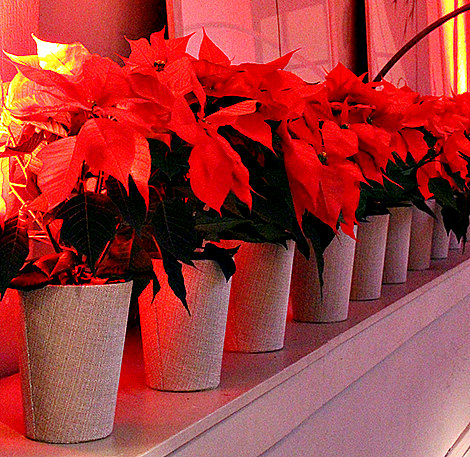
Poinsettias are NOT poisonous. For years poinsettias have undergone rigorous testing and there is no eveidence that these plants are poisonous. In fact, you would have to eat several bushels of poinsettia leaves to get an upset stomach!
Poinsettias have a milky white sap that is bitter to taste. If children get it on their hands or in their mouth - it tastes bad but it isn't going to hurt them. Nor will it hurt pets.
Over the years we've maintained hundreds of poinsettias in homes and offices with our corporate interior plant business. And during that time we've learned a thing or two about how to care for them.
Follow our guidelines for poinsettia care and you'll enjoy healthy and happy plants throughout the holiday season.
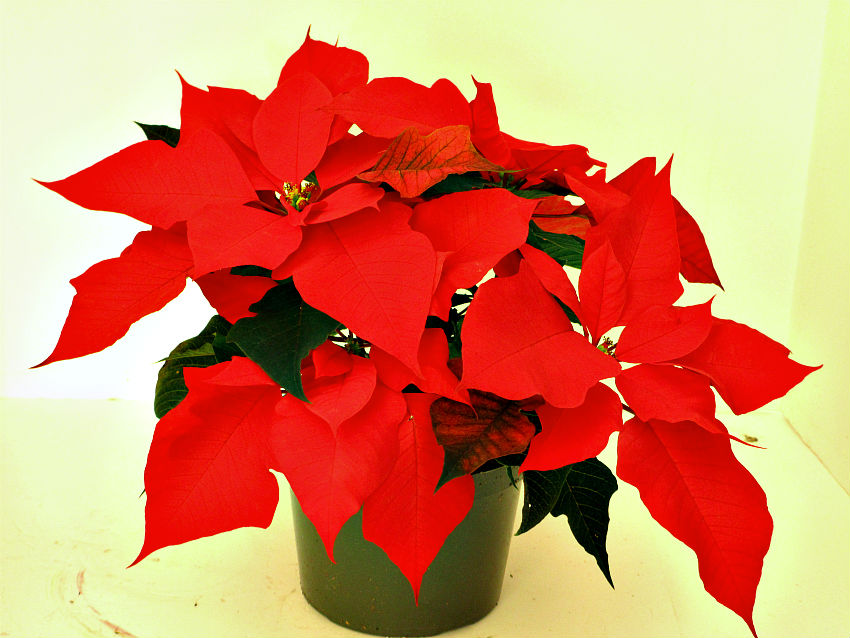 Enjoying beautiful poinsettias throughout the holiday season is easy
Enjoying beautiful poinsettias throughout the holiday season is easy1. Buying Poinsettias
Buy only "fresh" plants.
The actual poinsettia flower is at the top of the plant. (The brightly colored leaves that give the plant its color are called bracts.) The "flowers" at the top should be just emerging and look fresh and healthy. If they're shriveled or missing, the plant has been mishandled or its past its prime. Skip it!
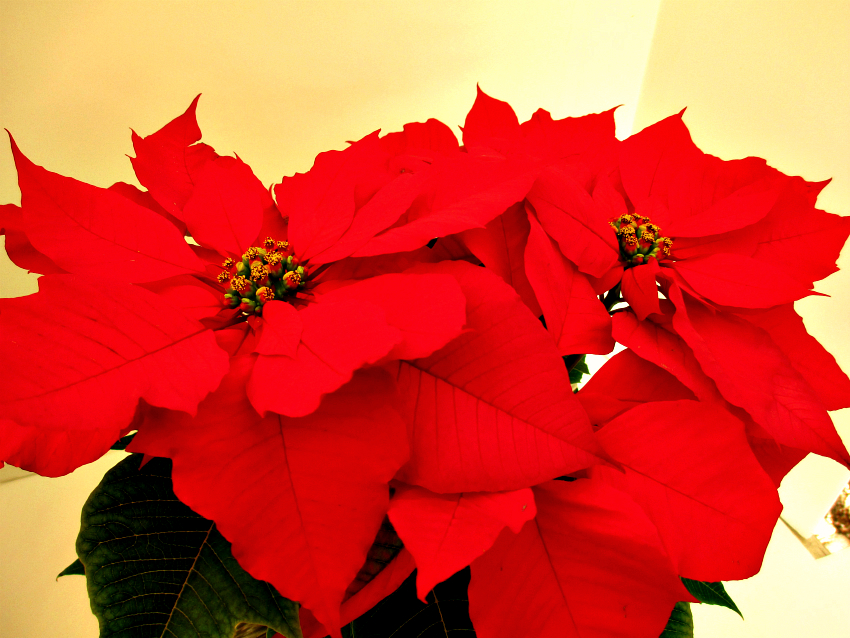 Flower buds are at the top of the plant and they should look fresh and healthy.
Flower buds are at the top of the plant and they should look fresh and healthy.Be careful with plants in plastic wrappers.
Many plants become dehydrated and their leaves wilt from lack of water while sitting in the store because the plastic wrappers they're shipped in make watering impossible. Poinsettias with droopy or wilted leaves rarely recover.
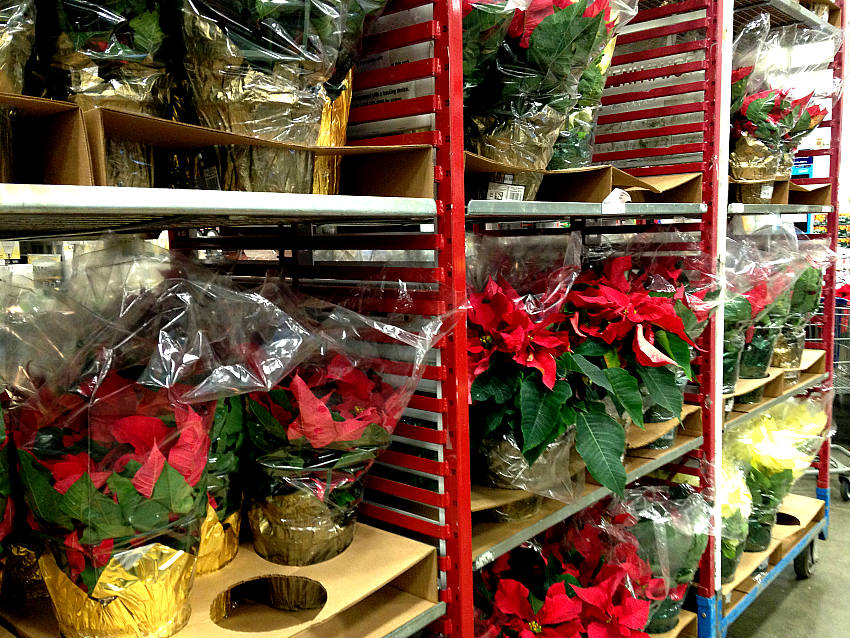 Choose plants carefully. Wilting, droopy leaves rarely recover.
Choose plants carefully. Wilting, droopy leaves rarely recover.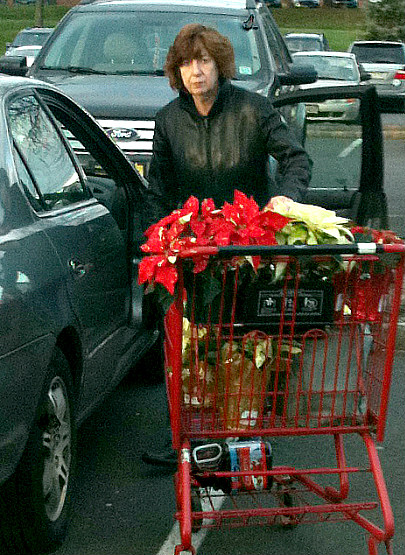 This is not the way to do it! Without protective wrapping, these plants can easily be damaged and will probably drop their leaves from the cold when they get home.
This is not the way to do it! Without protective wrapping, these plants can easily be damaged and will probably drop their leaves from the cold when they get home.Use protective wrappers when taking plants home.
Poinsettias damage easily and suffer cold damage in temperatures below 45 degrees. Take care in getting your plants home because if they start dropping their leaves. No amount of love and care will save them.
2. Poinsetttia Care Tips
Watering Guidelines for Poinsettias
Incorrect watering is the #1 killer of poinsettias.
Poinsettias are members of the Euphorbia family (Euphorbia pulcherrima) - which means they're actually related to cactus! So it's no surprise that overwatering is the #1 killer of these plants.
Poinsettias need to dryout between waterings so their roots get air.
The most practical way to judge watering is by weight. Lift the plant - if it feels light - like the pot is full of feathers - it's time to water. If it feels heavy - like the pot is full of bricks - better wait.
Typical watering schedule for poinsettias.
| Plant Size |
Pot Size |
Watering Interval |
Amount
of Water |
| Mini Table Top |
4
1/2" |
Twice
a week |
1/2 cup |
| Standard Table Top |
6" |
once a week |
1-2 cups |
| Large Table Top |
7" or 8" | once a week |
2-3 cups |
| Floor Plant |
10" |
once a week |
1-2 qts |
Make sure the soil is actually absorbing moisture when watering. Water slowly at first, then apply full amount. Plant food is not necessary.
Room temperature can make a big difference in your watering schedule. A plant in a hot office will drink twice as much water as a plant sitting in a cool windowsill at home.
Light for Poinsettias
- Poinsettias do not need sun. These plants have all the energy they need to last through the holiday season. Display them wherever they look their best - indirect lighting will be just fine.
Temperature
- Poinsettias enjoy cool temperatures. Even though they're tropical plants, poinsettias do better in cool temperatures - in the 55-65 degree range. Avoid the hot, dry air from your furnace by turning down the heat at night. You'll become uncomfortable long before your plants will.
Setting Up Poinsettias in Our Self Watering System
Getting Your Poinsettia to Rebloom

